
|
A GLANCE BACK: When utilities were local...
By Jack Authelet
Published: |
Thursday, November 10, 2011
First it was Tropical Storm Irene, followed all too quickly with a snow-laden pre-Halloween nor'easter, and like most other rampages of Nature that left much of the community without electrical power, recent storms have prompted many wishful glances at surrounding communities, particularly those with their own municipal electric departments, each providing an abundance of power for residents throughout the storm.
Inevitably, the question is raised as it has been many times in the past: Could Foxboro establish a municipal light department capable of producing and distributing electricity sufficient to meet the needs of residents and local industry?
"Could" is much easier to address than the "should" but in this age of always pushing forward to new frontiers, it would be enlightening to reverse ourselves and turn completely around for a backward glance. History is, and always has been, a great teacher. We might ask how a progressive community pushed ahead to satisfy the needs for any - or all - of their utilities more than a hundred years ago when all utilities were local.
|
Backward glance
For well beyond the first hundred years of life in this place called Foxborough, residents had few choices for heat, namely wood, coal or heavy blanket. For illumination, state your preference: candle, whale oil or kerosene? Beyond that, any power had to come from horse, ox, water, wind or people with a strong back.
Change would come, albeit slowly. Virgil Pond's box factory was the first industry to leave the outfall of a pond, in his case, Crack Rock Pond on North Street. In 1850, Virgil opted for a downtown location on Market Street when he started running his factory on steam power.
As the century progressed, the pace of change would quicken, and in rapid succession residents would have access to many utilities, i.e. electricity, natural gas, telephones and a host of other luxuries that quickly became necessities.
The first homes to gather admiring glances when fully illuminated at night were those of Oliver Carpenter on Cocasset Street and Erastus P. Carpenter on Maple Ave. and, after being burned out, his luxurious home at the corner of Central and Liberty, since moved to Central and Clark Streets. They tapped into the supply of natural gas used to illuminate and power the Union Straw Works (USW) on Wall Street (1853) in which they were both principals. They also had water from the reservoir USW built behind the Town House and were tied into the sewer beds the company installed down behind the factory (later expanded to serve the center of town) on the present site of Foxborough's composting area.
|
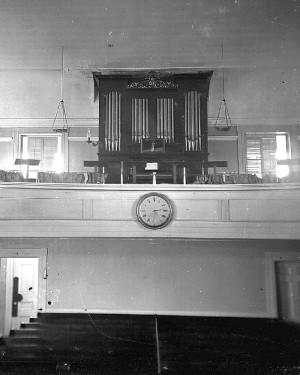
When erected in 1854, the interior of Bethany Church was illuminated by large oil lamps suspended from the ceiling. They were lowered for filling, lit, and then raised back into position for the length of the service. Eventually, such facilities would be illuminated by electricity generated here in Foxborough. (Foxborough Historical Commission photo)
The Union Straw works also extended its gas service to the Town House for use in municipal offices and to some downtown businesses. The firm also allowed selective use of its filter beds by the town and some businesses in the center.
A most amazing demonstration took place in 1878 (our Centennial year) when residents gathered in the Town House could hear the sound of a human voice transmitted over a wire from Boston. It was rather scratchy, due to limbs brushing against the wires, but residents could make out a few bars of "Yankee Doolittle" and they were hooked. It was a few years before the telephone became generally available to residents, but one might observe dinnertime was never quite the same again.
In 1892, after many obstacles were overcome, the Foxborough Water Supply District was formed providing water service to homes in the center and eventually spreading throughout the community. Water wells were sunk adjacent to the pumping station off Chestnut Street and pumped to a standpipe at the head of Glenwood Ave. Houses on Baker Street were the first to be serviced but the availability of the water marked the end of the "outhouse" years for families.
|
Street lights
Families of that era did remarkably well running their labor-intensive households, but there were matters of a more general nature which many wanted addressed. One was illumination of the streets at night. It was one thing to be in a wagon behind the horse. It was something else to have to walk in the dark over dirt roads, and they wanted something done about it. Not willing to wait, some homeowners added street lights to their own neighborhoods.
An article was brought to town meeting in 1888 which, if approved, would satisfy the need. Voters quickly approved authorization to form an organization to provide illumination for street lighting and other purposes. The group would be called the Village Improvement Association that would serve an area one mile distant from the Common.
It would be a quasi-public group, accepting donations to augment an annual appropriation from the town. Response was immediate, with $57 being donated, proceeds from an Old Folks Concert, and individual contributions ranging from $1 to $2.50. With $867.24 from the town based on the value of homes in the district, total receipts were $1,377.74.
The Wheeler Reflector Co. was charged with lighting and care of street lamps, 61 in number. The first bill for 20 nights equaled 1,220 lightings at 43/4 cents each for a total of $57.95.
Wood lamp posts and iron frames to hold the kerosene lamps came to $2.40 each.
The work of the district proved successful but came into question in 1889 when voters refused to appropriate the $400 requested. A second plea, for only $200 was defeated as well. Somehow, the district managed to continue providing illumination and no stated reason for voter action appears in the records.
In 1893, care of the lights became a local task when Wheeler Reflector Co. was replaced by local resident William Clark who became a familiar figure around the center on his nightly rounds to light the lanterns.
Each evening, except for moonlit nights, Clark would make his rounds with his white horse and wagon, the horse pacing off the distance between each light and always stopped in just the right place. The lamp lighter would then climb up on a bench installed in his wagon, trim the wick (which residents continually asked to be turned up higher), polish the globe and light the lamp.
Mr. Clark's first bill to the association was for illuminating 94 lamps for 19 nights at a cost of $44.65. The number of lights continued to increase, eventually reaching $60 for the billing period. The number of lights would keep increasing over the years.
But time was running out for kerosene lanterns as alternatives to kerosene were becoming available. In 1897, (the same year the town voted to extend Carpenter Street from its terminus at Clark Street and extend it to intersect with South Street) the end became obvious with the formation of the Foxboro Electric Co. Changes would come quickly but the Village Improvement Association would continue with a full agenda and street lighting would continue to spread throughout the town, but Mr. Clark's job as lamp lighter would be ended within the year.
|
More illumination
In 1894, residents marveled at the illumination of the original Massachusetts Hospital for Dipsomaniacs and Inebriates (followed by the Foxborough State Hospital) on Chestnut Street which generated its own electricity. The hospital and adjacent residential cottages also had heat from a central coal-fired plant and were tied into the hospital's filer beds for sewerage disposal.
The Van Choate Electric Co. on Neponset Ave., (also built in 1894) which held patents to make electrical devices also generated its own electricity, produced its own natural gas and had an in-ground septic system. The buildings later housed the Standard Gauge Co. (1908) which reorganized as The Foxboro Company in 1914.
These were remarkable changes, enjoyed by many residents who worked in these facilities, but what about the homeowners themselves, those for whom basic services were a real challenge?
When change did come, the pace was rapid but most welcome and was eagerly embraced by the town itself with the overwhelming endorsement of the majority present and voting at town meeting.
|
Foxboro Electric Co.
In 1897, a proposal was presented to the selectmen by a group of citizens seeking permission to erect poles and wires and to maintain same on the public highways of Foxborough, the purpose of which would be to furnish light, heat and power to the town and its citizens.
One resident urged a delay for what he thought would be an offer from the Van Choate Electric Company to expand its generating capacity to include electricity for the entire town. (It went into receivership in January, 1900.)
Another thought Foxborough should create its own generating and distribution system rather than having it commercially provided.
With the encouragement of the Village Improvement Association, they went with the local business option and work commenced immediately on a power house to be built at the end of a railroad spur line located off Wall Street. The spur line also brought railroad cars filled with coal to the adjacent Foxboro Coal Co.
One of the first orders of business was to petition Selectmen to provide electricity for street lights. The Village Improvement Association would support the request and a contract was signed. The agreement called for 102 lights to be illuminated during the year at $15.00 per light and to raise $300 additional to pay for the service, the entire cost of the 102 lights which the company offered to the town free for one year's service.
The contract was let for installing poles (130 feet apart) under the direction of Selection to Frederick S. Lane who would also string wires. The new powerhouse would have two boilers of 400 horse power each as well as an engine of 150 horse power and a 1000-light dynamo. The building would have an iron chimney reaching 75 feet from the ground.
On April 9, 1898 the first electric lights were illuminated in many businesses and part of the district and by the Village Improvement Association. Once residents saw the advantage of the incandescent lights compared to the kerosene lamps previously in use, there was a general expression of gratitude.
Hundreds witnessed the first illumination of the Common by four large lights placed around the oval and they expressed great pleasure in what they saw. Their reaction was mirrored by Foxborough residents in 1972 with the illumination of replicas of the original lanterns installed over the years as part of the "Save the Common Fence" initiative.
It was believed both Foxborough and Mansfield could be serviced from the plant and in an initial solicitation, the company said it would commence generating locally if 1000 customers signed up. The initial request brought 1,432 interested parties including many local industries and the Grange Hall on Bird Street. The town also agreed to extend service to the Town House (which housed all the town offices) the Engine House used by the Fire Company and Memorial Hall which for many decades would be home to Boyden Library.
Slowly, electrical service would spread throughout the community, bringing the promise of electrical appliances that would "end drudgery in housework."
|
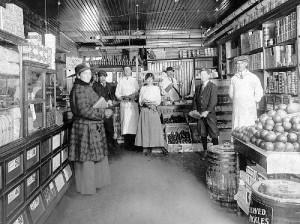
The Cash Store in the Central Street business district was one of the first downtown stores to be serviced with electricity. Wires were quickly strung throughout the building and the oil lamps became a thing of the past. This was a great convenience for housewives, many of whom shopped daily due to the inability to keep much food on hand due to limited space in their ice box. (Foxborough Historical Commission photo)
New players would come into the mix, offering an even broader availability of utilities, all produced, delivered and serviced locally. Could they keep pace with a growing community which moved beyond the straw hat era into a new industrial age?
It is a compelling story of daring to dream and working to fulfill what dedicated people were dreaming about. It is also a story rich in history from which energy-conscious citizens could gain many insights even today.
This story will continue in a future installment.
|
Local generating plants couldn't keep lights burning
Part 2 of a three-part series
By Jack Authelet
Published: |
Thursday, November 17, 2011
Foxborough strode confidently into the new century in those early days of 1900. The center of town was truly a wonder with street lights shining brightly and many homes, businesses and public buildings illuminated, at least for a few hours each day.
Nothing had prepared the community for the disastrous first few months, when Van Choate Electric went into receivership with the loss of the 500 jobs promised. A few weeks later, the former Union Straw Works, with the new line of spring hats ready for sale, burned to the ground. Literally days later, the greatest tragedy of all: the burning of the Town House with all the town offices and the Foxborough High School wing. It was the deadliest fire in town history, taking the life of three firefighters and seriously injuring a fourth.
Somehow, Foxborough had to pick up the pieces, and Albion Bemis, who owned the hat factory, viewed it as an opportunity to step back and envision a new Foxborough for the 20th Century.
That vision included being a community with a wide range of utilities not only for families but for an expanded business community and no time was lost. The dream would be realized, but not in ways they ever could have imagined
|
Expanded service
Each year brought additional streets into the lighting district and slowly the line of poles and wires spread out within a mile of the center of town. Residents suffered considerable discomfort in 1903 due to the scarcity of coal, which was generally unavailable at any price. Boyden Library only opened on Sunday due to the lack of heat. But fortunately, Foxboro Electric generators were oil-fired and electrical service continued uninterrupted.
|
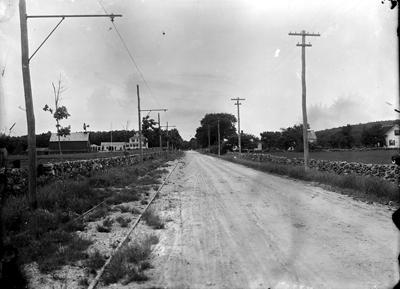
Lower Central Street is much busier now than when the first electrical wires were strung. The wire on the left powered the electrical rail cars operating between Mansfield and Norwood, while the wires on the right brought street lights to many neighborhoods and the promise of electricity for all (Foxborough Historical Commission photo)
Foxboro Electric added a brick chimney to its plant in 1905. It measured eight feet square at the base and rose to a height of 65 feet.
A separate group was formed in East Foxboro to provide street lighting there. Working with Foxboro Electric they had 34 street lamps in place by 1906, 14 of which were maintained by the Society, the remainder by the homeowners who had street lamps in front of the homes.
A major improvement at Foxboro Electric was the installation of a large oil storage tank in 1908. It was the largest tank ever transported by rail through Foxborough and required a special permit from the railroad. It was 32 feet in length, 10 1/2 feet in diameter, weighed 12 tons and held nearly 21,000 gallons of fuel.
Slowly, the system grew but the demands of setting poles, installing wires and maintaining the system were heavy. The supply of power was still limited to a set number of hours per day. The potential of the system was significant, but the increased consumption of electricity was making heavy demands upon Foxboro Electric and its generating plant off Wall Street.
|
Greater potential
There were those believed the local electric company could not produce sufficient power to spread the system to the entire community.
Improvements would have to be made, and they started at the top in the form of a total reorganization of the Foxboro Electric Co. under new ownership with a broader vision in May, 1910.
Ownership of the Union Electric Light Co. in Franklin changed at the same time, and a principal previously serving Union Electric took the helm at Foxboro Electric and also had responsibilities in Wrentham and Plainville.
The vast complex of industrial buildings of the former Van Choate plant on Neponset Ave. had been like a revolving door for companies wanting to move their business there or to launch a new venture from that site. The first hint of stability came in 1908 when B. B. and E. H. Bristol purchased the large expanse of vacant buildings on Neponset Avenue, purchased the Standard Gauge Co. of New York and moved it to Foxborough.
Since the plant had its own electrical generating plant, not much thought was given to any impact on electrical service in Foxborough. Quite the contrary: they saw opportunity.
As it turned out, E. H. and B. B. Bristol also had a willingness to help the community find its footing after the disastrous fires and financial failures of 1900. They had the capability to produce electricity far in excess of their own needs.
They entered into discussions with the new management of Foxboro Electric and all parties agreed that the capability of generating more electricity was far greater from the Standard Gauge plant than the facility on Wall Street.
Discussions led to an agreement to sell the electrical generating plant located between the two main buildings on Neponset Ave. owned by Standard Gauge to Foxboro Electric and, in a separate agreement, signed a five-year lease to purchase all of Standard Gauge's power from Foxboro Electric.
|
Major improvements
Once the shift was made, Foxboro Electric did all of its generating from Neponset Avenue. Customers saw an immediate benefit as power from the new plant would be available around the clock, seven days a week, rather than a set number of hours each day. Additional improvements in the system were also underway.
There was also an increase in voltage, from 188 cycles to 60 and from 104 volts to 110. This would be a problem for some, as many 104-volt lamps were in service and would be burned out by the higher voltage. They bought some time by increasing the voltage slowly, rather than as a sudden jolt, but the reality was customers would have to replace the older lamps.
Soon, electrical service would reach the first customers through the new generating plant and a new age dawned for the community.
|
Gas and Electric
The reorganization of Foxboro Electric and its purchase of the Standard Gauge generating capabilities appeared to insure the future of electric service to the community well into the future.
But Standard Gauge also had natural gas production capabilities far in excess of its needs. Based on that, a new plan emerged, with Standard Gauge officers and the Bristols heavily involved.
A new corporation, Norfolk-Bristol Gas and Electric Co. was formed in July of 1911. The stated corporate objective was to provide gas and electric services to all interested parties within the Town of Foxborough and to any other communities in Norfolk or Bristol County that might desire service.
|
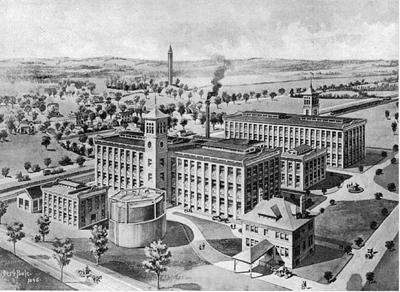
The gasometer (The tank in foreground) and adjacent gas house at the Standard Gauge Co. on Neponset Ave. were deeded over to the newly-formed Norfolk-Bristol Gas and Electric Co. with the intent of providing gas and electric service not only to Foxborough, but also nearby towns. The plan did not come to fruition. (Foxborough Historical Commission photo)
As initial planning for gas service got underway, electrical service continued its expansion into more neighborhoods while also offering possibilities many consumers had never imagined possible.
Foxboro Electric Co. also started selling electrical appliances in bold full-page ads in the Foxboro Reporter.
The company offered to install, free of charge, a separate meter from which wires would be run to a polarity wall receptacle. Customers could then operate electric irons, electric heaters, electric cooking utensils, washing machines, fans, motors, vacuum cleaners, sewing machines and other electrical apparatus for $1.00 per month.
"End the drudgery of housework," promised the ads. "End the servant girl problem. Electricity will sweep and dust, wash and dry dishes, wash and iron clothes, cook and sew. The human hand is needed but to guide the current. It need not do the work itself."
Electricity: The potential was enormous but one had to also deal with the reality of wires, poles and roadside trees. During one period of bad weather, heavy rain caused many short circuits in the system. The storm pulled one electric line from the crossbeam and the current jumped from the wire to nearby trees. The short circuit resulted in 60 tungsten bulbs burning out at a cost of $75 plus two men working all day on Sunday to repair the damage.
|
Major changes
In April of 1911, a new player came onto the scene in the form of South Eastern Massachusetts Electric Co. with capital of $150.000. Frank Coyne of Foxborough was one of the incorporators. The purpose of the company was to purchase and develop existing plants now in the counties of Norfolk, Bristol and Plymouth and to increase the capital of the incorporation from time to time, as added properties were acquired and extension and improvements made to plants the corporation may own at any time.
In July, the distribution system of Foxboro Electric which carried electricity to all the streets and homes serviced by the company was sold to C. D. Parker Co. of Boston. Foxboro Electric also sold back to the Standard Gauge Co. the power plant it had so recently purchased to expand local availability of electricity.
At that time, Parker had also purchased the lighting system at Franklin and the expectation was to supply Foxborough from that system as quickly as connecting lines could be laid. Parker also owned systems throughout the state.
In October of 1911, a hearing was held on a petition to locate poles on Main Street from the Wrentham Line to Davis Corner, now the junction of Main, North and Chestnut. The purpose of the line was to provide linkage to a power plant in Woonsocket.
The closing weeks of 1911 dealt with hearings on the consolidation of Foxboro Electric and Union Electric of Franklin under new management.
|
Turning point
With the question of consolidation still hanging in the balance, 1912 began with the electric company office moving to Franklin and plans for Union Electric to build a new supply line into Foxborough.
Plans were approved to erect poles between Main, Pine and North Cross Streets and extend service to East Foxborough and the demand for electrical services remained high.
In June, the consolidation of the two electric companies was approved by the state. The combined group would be known as Union Light and Power.
In August, a high tension line linked Foxborough to North Attleboro and by September, local consumption soared to a maximum single-day output of 386 killowatt hours, up from less than 200 just a year earlier.
The commitment to expand street lighting remained unchanged, 125 new street lights were added and the Village Improvement Association was still committed to the encouragement of full service for all.
The demand for electricity continued to soar as residents were clearly more concerned with availability than where it came from. But where would it end, and how? The answers will come in the Part 3 conclusion of this expanded series.
|
A GLANCE BACK: Demand overwhelms supply, utilities go regional
Last of a three-part series
By Jack Authelet
Published: |
Thursday, December 1, 2011
In a matter of a few months in 1911-12, local generation and distribution of electricity was passed to commercial interests operating from a broad base covering several towns. But local control had not been relinquished, and it was the Village Improvement Association (VIA), chartered to provide illumination for streets within one mile of the Common, that set the pace. Once a commitment was made to expand street lighting in more neighborhoods, residents gained the option of subscribing to electrical service.
As the domestic availability of electricity followed the street lights into the neighborhoods and local manufacturers welcomed the alternative to water and steam power, another opportunity arose that was, simply stated, delicious.
The Central Street Bakery, with its highly popular line of baked goods and desserts, added something else of even wider appeal: ice cream, frozen by electric power, and they offered the first ice cream cones sold in Foxborough.
|
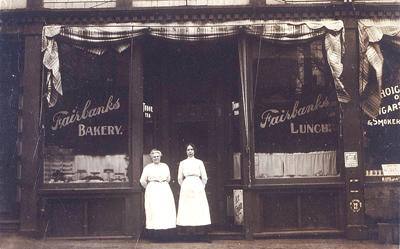
Electricity made many things possible, one of the more delicious being Foxborough's first ice cream cones, offered by Fairbanks Baker in the center business district once they purchased an electric ice cream freezer. (Foxborough Historical Commission photo)
Lighting was extended to East Foxborough via Chestnut Street and also to sections of Mechanic and South Streets. Funding was provided by the VIA and reimbursed by the town from betterment charges paid by homeowners who then had street lights.
|
Foxboro Gas Co.
The distribution of natural gas to homeowners in Foxborough and possibly Mansfield was back on the agenda in 1915.
The Norfolk-Bristol Gas and Electric Corp. had been formed back in 1910 to make commercial use of the gas producing plant at Standard Gauge Co. Watson Goodyear was a principal in the new corporation. He had come to Foxborough with E. H. and B. B. Bristol when they purchased the former Van Choate Electric plant on Neponset Ave. and brought Standard Gauge to town. That plan was slow to develop and collapsed when Goodyear returned to Connecticut.
The initiative resurfaced in a petition to form the Foxboro Gas Co., a gas producing and distributing entity which would produce gas at the former Van Choate plant. The contract for title to the gas plant was issued by The Foxboro Co., formed in the reorganization of Standard Gauge in 1914.
Lengthy layers of approvals were secured from state and local officials to generate the gas and distribute it for sale in Foxborough and Mansfield. Further permission was sought - and granted - to dig up the streets for laying the gas distribution lines.
While not many, there were critics of the plan, some of whom felt it should be the town providing the service and consequently collecting the revenue. When the issues of capital, liability and insurance were explained, objections were stilled.
Among the proponents of the gas franchise, which was approved, were the new superintendent and the head inspector of Union Light and Power.
|
Coming of age
Members of the Village Improvement Association remained diligent in their effort to bring street lighting to the entire community, but the process was both slow and cumbersome.
Street by street, residents waited but in the general sense, the community was slowly coming of age. The Foxboro Laundry Co. made its first pickup from customers via a motorized vehicle. Physicians were arriving by car to perform their house calls, and service stations were popping up throughout the community.
The concept of the Foxboro Gas Co. was viable and was most welcome in the community when first proposed. Residents had been disappointed by the disbanding of the Norfolk-Bristol Gas and Electric plan, as the service held so much potential for both business and residential customers. Four years had passed before Foxboro Gas took up the challenge. The planning and permitting was endless and before gas mains could be laid to connect customers, the opportunity was lost. There was no hesitation on the part of Selectmen when the Taunton Gas Light Co. came knocking on the door. Already operating in surrounding areas, they were licensed to distribute and sell gas in Foxborough and moved very quickly.
At the peak of building their distribution system, 80 workers were engaged in digging up the streets and laying pipe. They complained about finding "boulders in every road" but the work went on. When working on Wall, Central and Liberty Streets, they discovered some old wooden conduit from the gas distribution system of the Union Straw Works that had extended service to the Town House and some businesses in the center. They could still detect the odor of gas after more than 70 years.
|
Finishing touch
The gas distribution system was completed with installations on South Street in 1926, the same year that electric street lights finally reached down South to West Street. It was also the same year Massachusetts enacted compulsory auto insurance.
With no commercial ventures interested in the gas producing plant at the Foxboro Company, it was shut down in favor of the company purchasing future supplies from Taunton Gas Light Co.
Street lights in the vicinity of the Common, which had been installed early in the illumination process, were replaced with more modern lamps.
Over 400 street lights were now in service. Lamps which had originally been installed on every second pole were changed to higher intensity lights every third pole. It wasn't until 1927 that the Village Improvement Association extended street lights to the last of the streets still waiting, namely Oak, East and Granite.
But all wasn't well with consumers, many of whom had complained about increased rates for electricity. Their voices were heard on Beacon Hill and Governor Fuller challenged Union Light and Power to respond. The response not only included a reduction in rates but the replacing of many 40 candle power lights with 60.
|
District dissolved
At the annual meeting of the Village Improvement Association held in March, 1927, officers acknowledged that when the latest extensions were complete, all local roadways would be illuminated. They had set out to meet that challenge some 40 years earlier and had remained committed to the mission until it had been completed.
|

The hurricane of 1938 took a heavy toll on the distribution of electricity as seen in this photo taken on Cocasset Street. Some residents were without power for weeks but as long as the ice man could make his rounds, no food would spoil. (Foxborough Historical Commission photo)
The illumination of all streets was viewed as "an important matter; in fact, so important that it should no longer be cared for by an auxiliary association, even through efficient, but by the town itself."
Acknowledging that the first lights were erected as a guide for travelers, members of the Association pointed with pride to enhanced safety on the road, especially at intersections, the prevention of crime, and the general protection of life and property.
Town Meeting quickly approved assuming responsibility for the lighting district and to incorporate it as a town function.
The days of all utilities being local had long since passed. Could the illumination of street and the domestic availability of electricity that followed have been handled in a more expeditious manner? There would be little doubt about that but as clearly demonstrated, demand quickly exceeded ability to produce.
|
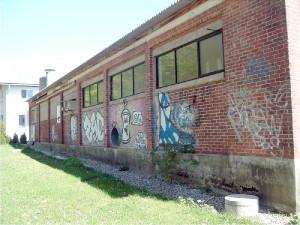
The Foxboro Electric Co. erected its electrical generating plant in 1897 which still stands at 29R Wall Street with the intent of providing street lamps and electricity for roads and buildings within one mile of the Common. The company would help “end the drudgery in housework” by providing electrical appliances at less than Boston costs. (Photo by Jack Authelet)
The communities that once held hope of receiving electricity and gas from Foxborough utilities had long since gone their own ways, some to commercial ventures, others to their own municipal departments.
Foxborough residents finally had assurances that however high their consumption might be, the regional utilities -- large enough to serve them, small enough to know them -- would provide their needs. Beyond that, there would be no limit to the number of businesses or residential units that could join the system and receive the same assurances, thus allowing the community to grow at its own pace.
The utilities would continue to grow in an effort to keep pace with demands and in many instances, regional became national. When, if at all, would "large enough" become too large? Could "small enough to know you" become one of the parts, the sum of which would be greater than the whole?|
















